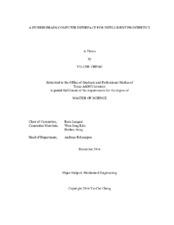| dc.description.abstract | Over the past few decades, many researcher have shown that human can use brain signals to communicate with computers or machines by using brain-computer interfaces (BCIs). BCI systems can measure the brain activity and translate them into control signals to external devices. A hybrid BCI system is to integrate two or more different BCI systems. By combining two different BCIs, the disadvantages can be eliminated and the advantages can stay.
One of the BCI developed in this thesis is electroencephalographic (EEG). EEG is one of imaging techniques for spontaneous recording of the electrical activity from the brain. The EEG has been widely used in research for cognitive and brain-state studies in psychology, neuroprosthetics, transportation safety and clinical diagnosis . In this thesis a commercial EEG product, NeuroSky MindWave, is used to measure the EEG signal from forehead. From the acquired EEG signal, humans attention and meditation level can be obtain. A EEG control algorithm is developed in LabVIEW based on the attention level, meditation level and eye blinks to control an intelligent prosthetic.
The other BCI used is eye-gaze tracking technology. Eye-gaze tracking technology is used to obtain the human's gaze direction. A eye-gaze tracking system is developed in this research. The system consists of a wearable self-build eye-gaze tracker with a scene camera, and the eye-gaze tracking algorithm developed in LabVIEW which can locate the eye pupil center and estimate the gaze direction.
Combing two BCIs above, a hybrid BCI system is complete. Suppose a person want to use a prosthetic arm to grab one specific item, the eye-gaze tracker provides the information of which item is the person want exactly, and EEG BCI controls the prosthetic arm to grasp the item. The hybrid BCI system is robust enough and have a reliable accuracy from the experimental result. | en |


